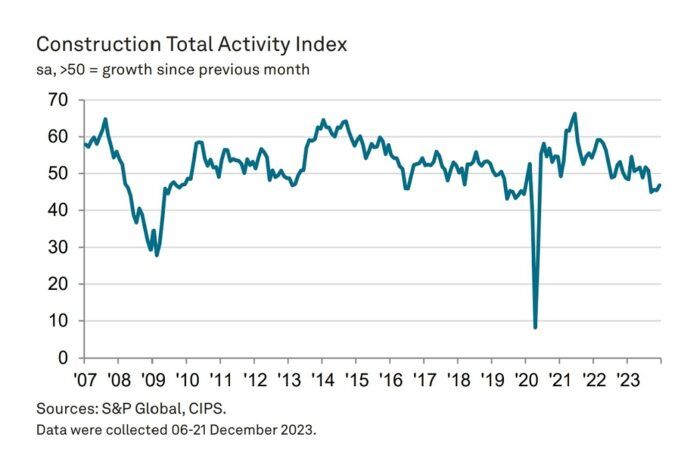UK construction activity experienced the slowest rate of decline in December since the trend began last September, the latest data has found.
At 46.8 in December, the headline S&P Global UK Construction Purchasing Managers’ Index (PMI) was below the neutral 50.0 mark for the fourth month running. However, the index was up from 45.5 in November and the highest for four months.
Category breakdown
The report explained that a sustained slump in house building was the main factor holding back construction output (index at 41.1 in December), which survey respondents linked to elevated interest rates and subdued confidence among clients.
Civil engineering activity (index at 47.0) also posted a softer pace of contraction at the end of last year.
Commercial construction meanwhile declined only modestly (index at 47.6), but the speed of the downturn accelerated to its fastest since January 2021. Some firms noted that concerns about the domestic economic outlook, alongside elevated borrowing costs, had led to greater caution among clients.
Total new work decreased at the slowest pace since the current period of decline began in August 2023. Subdued customer demand across the house building sector was often cited as a factor leading to reduced order books.
A softer decline in new work and hopes of a turnaround in demand conditions during 2024 contributed to a renewed rise in employment numbers in December. However, the rate of job creation was only marginal.
Purchasing and supplies
Mirroring the trend for construction output, latest data indicated the slowest fall in purchasing activity for four months. Where a decline in input buying was reported, this often reflected a lack of new work to replace completed projects.
However, improving supply conditions continued in December, with delivery times for construction items shortening for the tenth month in a row. Price discounting among suppliers contributed to a moderate fall in average cost burdens across the construction sector at the end of 2023.
Lower demand for construction products and materials also resulted in shorter wait times for suppliers’ deliveries in December.
Survey respondents often noted that competition for market share among suppliers had led to price discounting at the end of last year. Average cost burdens across the construction sector decreased for the third month running in December, albeit only modestly and at the slowest pace during this period.
2024 outlook
Despite all this, around 41% of the survey panel anticipates an increase in business activity over the course of 2024, while only 17% predict a decline. Anecdotal evidence suggested that subdued forecasts for the UK economy were a key concern, while hopes of reduced interest rates and a turnaround in market confidence were factors cited as likely to boost construction activity.
Industry comment
Brian Berry, chief executive of the Federation of Master Builders (FMB), commented: “December’s Construction Output data once again shows a continued decline in house building rates, with commercial construction rates also down. There are, however, positive signs that the rate at which activity within the industry is declining is starting to slow, giving hope that 2024 may be a year when we finally start to see improvement. If the government is serious about substantially boosting the UK’s house building rates and the wider construction industry, it must look at this as an opportunity to make real progress.”
Brian continued: “In recent months the government has taken some modest positive steps – providing tax cuts which will benefit small businesses and introducing new proposals for how the planning process can be expedited. The announcement shows promising signs that the measures will have a positive impact, but the government must not take this as ‘job done’. House building rates are still continuing to decline, and a comprehensive action plan is necessary if the UK is to deliver on the increased confidence of construction companies that 2024 will bring a rise in business activity.”




